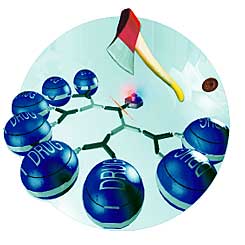Both cancer cells and materials used to make bombs can escape detection because they are present in tiny amounts too small for existing detection methods. Tel Aviv University solved the problem

Chemists from Tel Aviv University succeeded in developing a device for detecting microscopic signs of cancer, bombs and contaminated water. Both cancer cells and materials used to make bombs can escape detection because they are present in tiny amounts too small for existing detection methods. Tel Aviv University in Israel has developed the absolute solution: a probe capable of amplifying weak traces of "hidden" substances so that they can be located and observed.
Using molecular methods from the field of nanotechnology, Professor Doron Shabat from the School of Chemistry at Tel Aviv University has prepared new probes capable of locating target substances as biomarkers in cancerous tumors, chemical groups in explosives or pollutants in water - even when their presence is minimal. Professor Shabbat's discovery, which is a kind of supernatural "nose", is able to locate by "sniffing" these moles, which exist in minute quantities, and increase their quantity tenfold so that they become visible to the eyes of doctors and saboteurs.
Professor Shabat, a bioorganic chemist, intends to develop the method so that it can increase the strength of signals by a million and a billion times more than its rate today. "We are developing a molecular system that amplifies certain chemical events," explains the professor. "In this way we will be able to respond more quickly to medical, security and environmental threats. In fact, our device is able to amplify almost any chemical system that has some activity."
"It has the ability to help doctors diagnose diseases - those that produce biomarkers (certain substances characteristic of each and every disease) or have enzymatic activity that is adapted to our molecular probe," adds the researcher.
"The long list also includes some types of cancer, such as prostate cancer. But it also has the option of testing pollutants in water reservoirs. It has both biological and non-biological applications.”
Professor Shabat's invention is a molecular detector that works in solution. The tester adds tiny amounts of the tested substance directly from the field - for example, a teaspoon of contaminated drinking water - and simply notices if the solution changes color. If this is indeed the case - the cancer, the explosive or the pollutant - are present in the sample.
For now, Professor Shabat's method is unique. The prototype is already ready, and Professor Shabat plans to use it to "amplify" problems that exist in our world to improve the health, security and safety of humanity. Part of the research behind the invention was carried out in collaboration with the Scripps Research Institute in San Diego, USA.
The research findings appeared in an article published in the scientific journal Chemical Communication last year.

6 תגובות
big…….
In the case of prostate cancer, where should this device sniff?
Dr. Nachmani has many inventions on the topic of detecting low concentrations of substances.
You wrote that there is an invention, but you did not write what it is.
So what did we learn anyway:
That there is another invention in the field and that Professor Shabat is also involved in this field.
mmm…
Reminds a bit of an invention by a researcher from the Technion regarding a biological nose capable of "smelling" types of cancer. makes me think...
"Molecular detector working in solution" - I assume that this is a certain reaction that occurs and is distinguished even with the amount of small particles. It's just a shame that we didn't mention an example of the reaction that takes place...